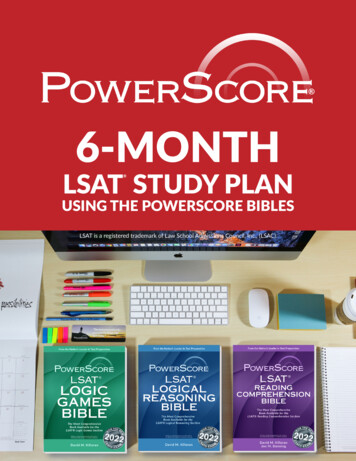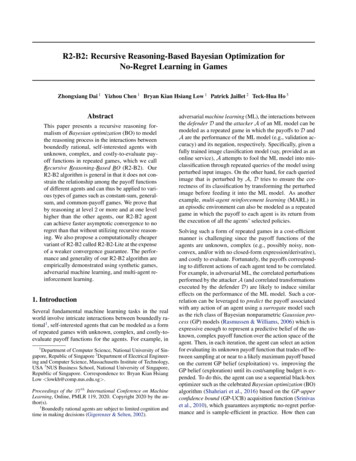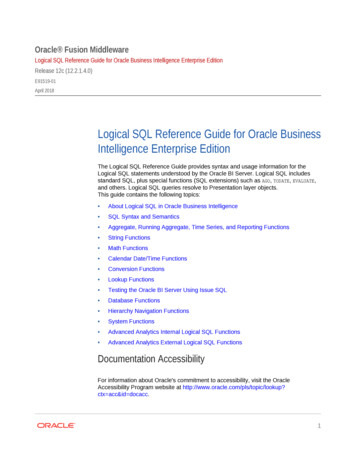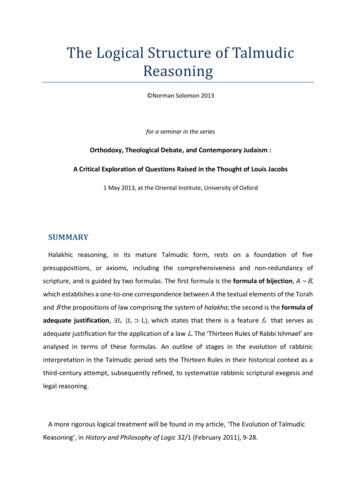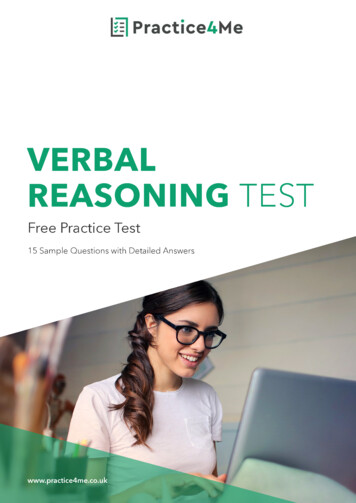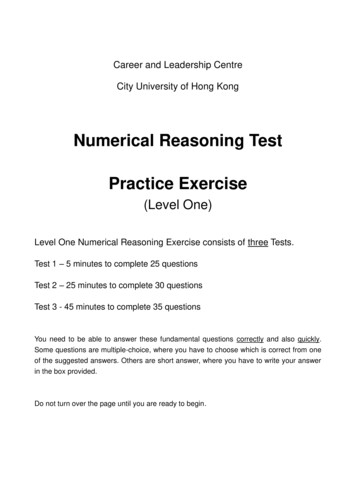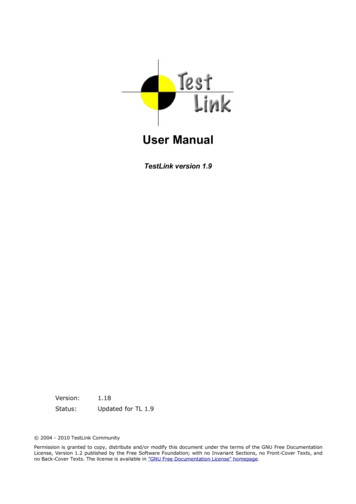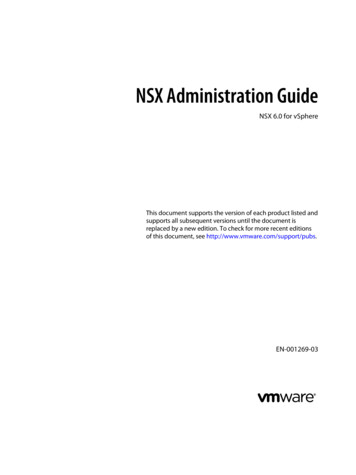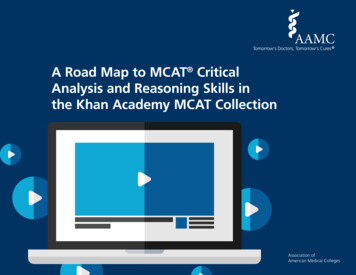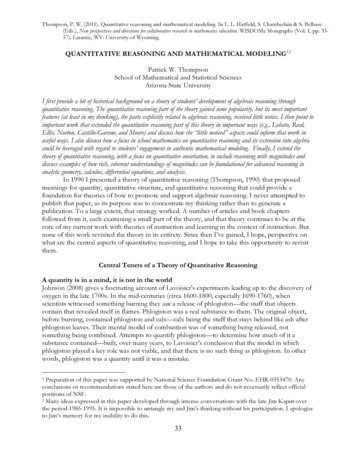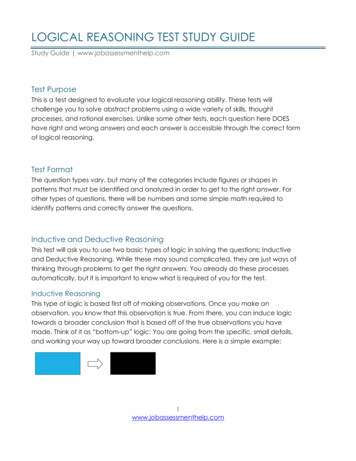
Transcription
LOGICAL REASONING TEST STUDY GUIDEStudy Guide www.jobassessmenthelp.comTest PurposeThis is a test designed to evaluate your logical reasoning ability. These tests willchallenge you to solve abstract problems using a wide variety of skills, thoughtprocesses, and rational exercises. Unlike some other tests, each question here DOEShave right and wrong answers and each answer is accessible through the correct formof logical reasoning.Test FormatThe question types vary, but many of the categories include figures or shapes inpatterns that must be identified and analyzed in order to get to the right answer. Forother types of questions, there will be numbers and some simple math required toidentify patterns and correctly answer the questions.Inductive and Deductive ReasoningThis test will ask you to use two basic types of logic in solving the questions; Inductiveand Deductive Reasoning. While these may sound complicated, they are just ways ofthinking through problems to get the right answers. You already do these processesautomatically, but it is important to know what is required of you for the test.Inductive ReasoningThis type of logic is based first off of making observations. Once you make anobservation, you know that this observation is true. From there, you can induce logictowards a broader conclusion that is based off of the true observations you havemade. Think of it as “bottom-up” logic: You are going from the specific, small details,and working your way up toward broader conclusions. Here is a simple example:1www.jobassessmenthelp.com
You have observed that the color of the shape has changed.You have observed that the shape, size, angle or number of shapes has not changed.Therefore, color is the changing variable.o Being able to identify the changing variable is key to these questions. If you can findthe changing variable, you know what to pay attention to and you can solve thesepuzzles much easier.CHANGING VARIABLES in Inductive Reasoning:Above, you have seen color change as an example of a changing variable. There canbe many other variables that change as well. Keep the following list in mind when youare analyzing figures and shapes on this test: Color Change (Did the shapes change color?).Number Change (Did the number of shapes change between the two pictures?).Angle rotation (Did the shapes turn, move, or shift angles?).Mirroring (Is the shape flipped, as if you were looking in a mirror? Remember, shapes canflip in two directions- vertically and horizontally.).Movement (Where is the shape in the picture? Did it move?).Size (Did the shape get bigger? Smaller?).Folding/Symmetry (Did the shape fold in some way while still maintaining its integrity?).Deductive ReasoningIf Inductive Reasoning is “bottom-up” logic, Deductive Reasoning is “top-down” logic.Deductive logic starts with a “premise”, which is usually a fairly broad statement. Onceyou have accepted the premise as true, it is your task to deduce toward a morespecific, detailed conclusion. The basis of truth in this case is having a valid premise tobegin with. Here is the classic traditional example of deductive reasoning (which is abasic form of Syllogism). If Socrates is a manAnd all men are mortalThen Socrates is mortalThese types of questions can be confusing, but all must follow the same simple formula.Let’s look at these three statements again, this time with each statement labeled. If Socrates is a man (A)And all men are mortal (B)Then Socrates is mortal (C)2www.jobassessmenthelp.com
In order for any of this to be true, A must equal B (A B). Sometimes, logic questions canbe solved by proving that A does NOT equal B, therefore that logic is invalid (think ofthis when trying to eliminate incorrect answers).The basic formula for syllogism questions is this:If A BAnd B CThen A C.Questions will get much more complicated and involve many more variables thanthat, but the principles of deductive reasoning still apply. You start with “truths” onbroad premises, and you can deduce logic towards an answer using the formulaabove.3www.jobassessmenthelp.com
Question TypesFigural AnalogiesFigural Analogy questions are testing your ability to identify relationships betweendifferent figures, and then to identify patterns within those relationships. These questionscan be incredibly simple, but also can be incredibly difficult.Example:Which of the following options below belong in the blank square above?The correct answer to this question is C. The relationship and pattern here is that thereare smaller, matching shapes inside the larger shape in the first column, and then thereis a corresponding shape that does not have the inner shape in the second column.The triangle shows us this pattern, so the logical conclusion is that C, the circle with noinner circle, is the right answer.Tips: Take your time and look closely. Make sure you study each element of the figures andpatterns. There are often hidden things in these figures that you might not catch on firstglance.The answers are right in front of you! This is true in more ways than one.o If there are 4 answer choices given, use those to help you identify the pattern. Multiple choice answers are part of the question- READ THEM and use themto help you solve.4www.jobassessmenthelp.com
oAll of these questions are solvable by logic. If you know the pattern, these are easyquestions! Only guess if you are truly stumped. Most of the time, you will be able tolook at the question long enough and crack it.Figural MatricesFigural matrices are a group of shapes in a rectangular matrix that are related to eachother, and ultimately have a solution or pattern based on the development of thefigures through the matrix. These questions are similar to the figural analogy questions.However, these are often more complicated with more going on in each figure. Thismeans it is very easy to get distracted, or have trouble finding the pattern through themany shapes within the figure. As with all of these questions, the key to success isfinding the patterns.Example:Which of the following options belong in the blank square above?This is a difficult question because there are a lot of distractions. However, the onlydiscernible pattern here is the increasing dots along the right column. In the first row,there is a shape with one dot. In the second row, the shape is accompanied by twodots. So the third row must have a shape accompanied by three dots, whichcorresponds with answer A.5www.jobassessmenthelp.com
Tips: Focus on two figures at a time. Taking in the whole matrix can be overwhelming, so focuson comparing just two next to each other. This makes it much easier to find differences andidentify potential patterns.The answers are right in front of you! This is true in more ways than one.o If there are 4 answer choices given, use those to help you identify the pattern. Multiple choice answers are part of the question- READ THEM and use themto help you solve.o All of these questions are solvable by logic. If you know the pattern, these are easyquestions! Only guess if you are truly stumped. Most of the time, you will be able tolook at the question long enough and crack it.Figural Next In-SeriesFigural next in series questions are asking for a very specific type of analysis and onlyrequire one skill. You must identify a series- a pattern that is predictable and has alogical “next” in the sequence. This requires the evaluation of different shapes andrelationships between shapes within a square and shapes between squares.Example:Which of the following options belong in the blank square above?6www.jobassessmenthelp.com
The correct answer here is B, because it satisfies all the discernible patterns. First, youhave a rotating triangle. Notice that all of the correct answers have the trianglepointed in the correct direction. Next, you must look at the crosses in relationship to thetriangle. In the top row, there are three blue crosses, followed by a triangle with oneblue and one red. In the bottom row, there are three red crosses, which indicates youshould be looking for two crosses, one red and one blue. B has this and is the correctanswer.Tips: Remember that this is a series! The patterns and relationships exist, and you know that it isleading you towards a resolution. Since you know the series ends in the blank square orspace, you have linear movement toward the end of that series. This could help you sortthrough the answers and find the right oneHaving trouble finding the pattern? Plug in each of the multiple-choice answers and see bytrial and error if you can find the right solution, or at least identify the pattern in the othersquares.Figural Odd One OutFigural Odd One Out questions ask you to identify a pattern between figures and findthe one that clearly does not fit that pattern. This is another type of skill being asked forhere, as you not only have to identify the pattern that fits for three, but also find onethat does not fit the pattern.Example:Which of the following options does not fit with the other three?The answer to this odd one out is fairly simple. D has a circle with only one line bisectingit, while all of the others have 2 lines going through the circle.7www.jobassessmenthelp.com
Tips: The easiest thing to do for these questions is to find the commonality between three, andthen figure out the difference for the fourth. Since three will all have some element incommon, that will be the easiest thing to spot when looking for a pattern.Don’t get distracted! Often, these questions try to trick you, when there is a simple andobvious difference between one of the figures. Try to focus on similarities and differencesand not the distractors.Figural A/B SetsFigural A/B Sets can appear tricky at first, but are actually quite simple. You have twochoices here, subtraction or combination. In both cases, the key first step is to identifynumbers, letters or names that appear in both sets. If you are subtracting, take the setbeing subtracted out of the primary set. For example, if the question asks A-B, youwould remove all the names that appear in B and A, and remove them from A. Thus,the right solution is only what remains in set A. For a combination problem, simply seewhat values are repeated, and only include those in the correct answer once. So ABwould be a merger of all values, without repeating values.Example:Set A1, 3, 5, 7, 9Set B3, 4, 5, 6,7Solve: A-BThe answer here is 1, 9. You are subtracting B from A. So you must eliminate allrepeated values that occur in both A and B from A. Thus, 3, 5 and 7 are eliminated,leaving only 1 and 9.Tips: Practice and get used to the questions. These can seem confusing at first, but once youfigure out the trick, these are incredibly easy.Be careful. Make sure you are subtracting or combining according to what the questionasks, and make sure you match up the figures correctly when looking for repeat values.These questions lend themselves to simple mistakes.8www.jobassessmenthelp.com
There should be no guesswork here. As long as you are careful and are doing the correctoperation (which also should come down to care and attention) you should get thesequestions correct.SyllogismSyllogism is classical logic. If A B, and B C, then A C is the fundamental principle youneed to remember here. These questions are all solvable using syllogism like theformula listed above. They will be infinitely more complicated than that simple formula,but the principle remains the same. In most cases, these questions will containnonsense, made up words as names for things so that you have to focus on the logic ofa statement and not allow outside knowledge of things or events aide you inanswering the questions.Example:A BROG is similar to a GRANGY but longer and thinner. A FUVET is like a DRANGO but isshorter and thicker. A DRANGO is like a GRANGY but is shorter and thinner.Statement: A BROG is like a DRANGO only much longer and thinner. TrueFalseCannot SayThe answer here is cannot say. The statement clearly states that a BROG is similar to aGRANGY only longer and thinner, and that a DRANGO is shorter and thinner than aGRANGY. Thus, the statement about BROGS being longer than DRANGOS is true,however we cannot say if BROGS are thinner than DRANGOS. Both BROGS andDRANGOS are thinner than GRANGYS, however there is nothing in the statement thatsays whether BROGS or DRANGOS are thinner.9www.jobassessmenthelp.com
Tips: Break it down one statement at a time.Write down things to help you organize and keep it straight. It may be too much to have inyour head, but by writing things down you can keep it straight and arrive at the correctanswer.Do not stray from your syllogism principles. Do not use outside knowledge or perception toanswer the questions, only what is presented.REMEMBER: If A B, and B C, then A C.Seating Arrangements/ Logical OrganizationThese questions require a similar type of thinking as syllogism, but look very different inhow the questions are asked. These questions will ask you to logically analyze asituation given certain parameters and find the best, most logical solution that meetsall the requirements.Example:First period history class has seven students, and the teacher must make a seatingarrangement based on the following requirements: Students 1, 2, & 3 are girls, while student’s 4, 5, 6, & 7 are boys. Your seating arrangementmust alternate boy/girl.Students 2 and 4 just broke up, and cannot sit next to each other.Students 6 and 7 are best friends and can’t stop talking, so they need to be placed as faraway from each other as possible.Students 3 and 5 are both excellent students and can help focus the weaker students.Students 2 and 7 have been close friends since elementary school and have requested tosit together.Which seating arrangement should you choose? A: 4,2,7,3,6,1,5B: 7,2,5,1,4,3,6C: 2,5,1,7,3,4,6D: 6,1,7,2,5,3,4B is the correct response here, as it satisfies all the requirements given in the question.10www.jobassessmenthelp.com
Tips: If given multiple choice answers, evaluate each answer and look for places where itviolates one of the parameters set out. The right answer will not violate any of the rules, soyou can eliminate answers easily that you find a problem with. This will almost assuredly cutdown the possible answers to either three or two choices, and perhaps even leave youwith the one correct answer.o Process of elimination is always your friend!o With multiple choice answers given here, you don’t have to re-invent the wheel!Always double check to make sure your chosen answer does not have a problem. Thereare so many moving parts to these questions and rules to follow; it is easy to overlooksomething. Double-check to make sure you don’t lose a point on a silly mistake!Write things out as you read through the information. Once again, there are a lot ofcomponents here, and writing things down will help you sort through it all.It is ok to use trial and error. Try to make a seating chart by following the rules, and then youcan go back and tweak it if you notice problems. This is a great strategy if you like to workon things actively and hands-on.Inductive ReasoningInductive reasoning is when one begins with observations and using those observationsand logical generalizations, one can come to conclusions based off of verifiableobservation. These types of questions can be confusing because it is hard to “prove”,but each question has an answer that is best and “most logical” based on theinformation you have been given.Example:You are searching for a new apartment and have the following criteria in what you wantin your new home.-2 bedrooms (highest priority)1 bathroomModern appliances in kitchenWood floorsPet friendly11www.jobassessmenthelp.com
You have visited the four apartments below:APT #1: 1 bed, 1 bath, modern appliances, including washer and dryer in unit, woodfloors and pet friendly.APT #2: 2 bed, 1 bath, wood floors, pet friendly, washer and dryer in unit.APT #3: 2 bed, 2 bath, wood floors, modern appliances, no washer and dryer in unit.APT #4: 2 bed, 2 bath, wood floors, modern appliances, no washer and dryer in unit, petfriendly.Of the 4 choices listed above, which apartment should you choose?Explanation: Apt #4 is the correct answer because it meets all the criteria listed in theprompt. The only negative is not having a washer/dryer in unit, but that is not listed onthe required criteria. Apartments 1, 2, and 3 all have at least one criteria they do notmeet, leaving apt 4 as the correct answer.Tips: FOCUS on the FACTSo The test provides you with enough factual information for you to get to the bestanswer. In order to make the right logical conclusions, you must read andunderstand all of the facts to properly contextualize your logic.Trust your instincts and common senseo Do not overthink these questions; the answers are usually fairly straightforward andeasy to understand through a logical series of thoughts.Check your answers back against the factso Does your answer choice align with the facts given? Double-check to make sureyou are following all of the rules!Use written aids to help youo These questions can often have a lot of information and can be hard to take in. Donot hesitate to write notes or make some kind of graphic organizer to keep all of theinformation straight.12www.jobassessmenthelp.com
Deductive ReasoningDeductive reasoning, opposite of inductive reasoning, is when one begins with abroad theory and using logical reasoning, one can deduce a fact. These types ofquestions can be hard because they can seem vague and difficult at first, and youmay think “how am I supposed to know” or even “that is an opinion, not a fact.”Remember, each question DOES have a correct answer. This is yet another case whereyou need to choose the “best” answer using logical reasoning.Example:After the last day of the season, there was a three way tie at the top of the basketballleague standings. The Hawks, Wildcats, and Tigers all finished with the same record 8-2.Here are the league tiebreaker rules: In the event of a tie in terms of final record- head to head results will determine who finisheshigher in the standings.In the event of a three way tie, the record against the other top teams will be consideredthe tiebreaker.If the teams are still tied, point differential in the games between the other two teams willbe used to break the tie.Many coaches in the league are very unhappy with this tiebreaker rule because theyfeel in encourages poor sportsmanship. Which of the following statements bestencompasses these coaches’ arguments?A. The rules are unfair because they favor higher scoring teams.B. The rules encourage teams to run up the scores on other teams.C. The tiebreaker should take into account record against the fourth place teams rather thanfocus on differential.D. The tiebreaker should not exist, and teams should share the championship.Explanation: B is the correct answer. That is the argument that is directly tied tosportsmanship, and since the tiebreaker values point differential, it is a valid complaintbecause it does encourage running up the score.Tips: Trust your instincts and common sense.13www.jobassessmenthelp.com
Do not overthink these questions; the answers are usually fairly straightforward andeasy to understand through a logical series of thoughts.o You need to read and understand the facts in order to think logically to answer thequestion. Read the facts, but the trick here is proper logic, so reading andunderstanding the answer choices is really the key.Use written aids to help you.o These questions can be confusing and hard to keep straight in your head. It wouldmake sense to make logic maps in order to track your thinking and make sure yourlogic is sound to arrive at the right answer.REMEMBER- your task is to DEDUCE.o Take what you are given and deduce the correct answer. While this is not easy,remember what the question is asking you to do and don’t get bogged down inworrying about things unrelated to the question. Focus on using deductivereasoning to arrive at a logical conclusion.o 14www.jobassessmenthelp.com
Deductive Reasoning If Inductive Reasoning is "bottom-up" logic, Deductive Reasoning is "top-down" logic. Deductive logic starts with a "premise", which is usually a fairly broad statement. Once you have accepted the premise as true, it is your task to deduce toward a more specific, detailed conclusion.
